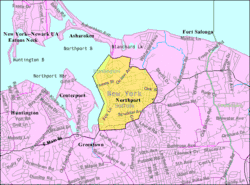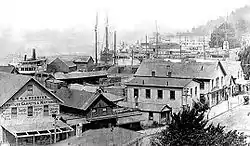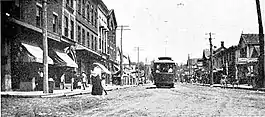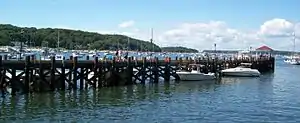Northport, New York
Northport is a historic maritime village on the north shore of Long Island, New York. Initially designated Great Cow Harbour by 17th-century English colonists, the area was officially renamed Northport in 1837. In 1894, in an effort to localize governance, the community incorporated as a village.
Northport, New York | |
|---|---|
Village | |
 Main Street in Northport just east of Woodbine and Bayview Avenues | |
 | |
 Northport, New York | |
| Coordinates: 40°54′10″N 73°20′39″W | |
| Country | |
| State | |
| County | Suffolk |
| Township | Huntington |
| Settled | 1656 |
| Incorporated | 1894 |
| Government | |
| • Type | Incorporated Village |
| • Elected Officials | Mayor: Damon McMullen
Deputy Mayor: Vacant Trustees:
|
| Area | |
| • Total | 2.53 sq mi (6.55 km2) |
| • Land | 2.30 sq mi (5.96 km2) |
| • Water | 0.23 sq mi (0.59 km2) |
| Elevation | 0−59 ft (0−18 m) |
| Population (2010) | |
| • Total | 7,401 |
| • Estimate (2019)[2] | 7,273 |
| • Density | 3,158.05/sq mi (1,219.30/km2) |
| Time zone | UTC-5 (EST) |
| • Summer (DST) | UTC-4 (EDT) |
| ZIP Code | 11768 |
| Area code(s) | 631 |
| FIPS code | 36-53396 |
| GNIS feature ID | 0958968 |
| Website | northportny |
Northport is known for its Victorian era village center, still bearing trolley rails from a long since discontinued streetcar line which would transport village residents to the Long Island Rail Road station in East Northport. The village Main Street runs from the Village Green along the harbor-front to the former hamlet of Vernon Valley, which has since been subsumed by the neighboring community of East Northport. As of 2010, the village has a population of around 7,401[3] and is served by the Northport-East Northport School District.
History
European settlement
The original inhabitants of the area now known as Northport were the Matinecocks, one of 13 Native American tribes of Long Island. The Matinecocks called this land Opcathontyche, which meant "wading place creek".[4] After Dutch interest a few years earlier, the land was sold by Chief Asharoken, head of the Matinecocks, to three Englishmen in 1656.[5]
With land that was well suited for farming, the early settlers grazed cattle on pastures around the harbor. The area soon became known as Great Cow Harbour.[6] (The nearby hamlet of Centerport was known as Little Cow Harbour.) The oldest house still standing in Northport, the Skidmore House on Main Street, was built in 1761. In 2009 the house was put up for sale, sparking the village to pass a historical preservation law.[7]
Growth, change, and shipbuilding

In the early 19th century Great Cow Harbor was still a rural farming community. By the 1830s the village contained only eight dwellings.[8] But a new industry of shipbuilding brought rapid change and growth. The village shifted away from its farming roots as shipbuilding became the community's primary industry. By 1837 the village was being referred to as Northport.[4]
The 1860 census listed Northport's population at 1,016. By 1874 it had become the most flourishing village on Suffolk County's north shore, with three ship yards, five sets of marine railways, two hotels, and at least six general stores.[8]
Northport's shipbuilding boom lasted fifty years but waned at the end of the century as steel-hulled ships began replacing the wooden vessels produced in the village.[4]
Railroads and trolleys

On April 25, 1868, the Long Island Rail Road opened a station within the village of Northport.[9] This was an essential transportation link for the village, especially for the growing commuter population. However, just a few years later the LIRR decided to move the Northport station to a new location in Larkfield to facilitate further railway extension to Port Jefferson. The new railway station located on Larkfield Road was opened on January 13, 1873,[10] and retained the station name of Northport.
To avoid confusion with the former station located in the village of Northport, train conductors would refer to the station in Larkfield as "East of Northport" because the station was located east of the Northport railway junction which directed trains north to the station located in the village. Despite the fact that Larkfield was primarily south of Northport, the area became known thereafter as East Northport.[11] The original rail spur to Northport was afterwards known as the Northport Branch. After the old village station closed in 1899, Northport decided to build a 2.5-mile (4.0 km) trolley line to take commuters between Main Street and the new Northport station located in Larkfield. The new commuter trolley opened in mid-April 1902. The trolley would eventually become obsolete with the increasing popularity of the automobile, and the trolley made its last scheduled commuter run on August 19, 1924.[12]
Incorporation and annexation
Although it was known by the name of Northport since at least 1837, the village of Northport was not formally incorporated until 1894,[6] becoming the first village in the Town of Huntington to do so.[4] Over the years Northport has expanded from its original borders, annexing other established communities.
Around the Revolutionary War, a concentration of 31 families began settling 1.5 miles (2.4 km) east of Northport, around where Main Street and Route 25A now intersect 40.8995°N 73.3296°W. This settlement was originally known as Red Hook[4] and changed names to Vernon Valley in 1820.[6] By 1874 Vernon Valley had a population of around 150 inhabitants.[8] Vernon Valley became part of Northport in the mid-20th century.[8][13]
Northport also annexed the formerly independent settlement of Crab Meadow 40.9207°N 73.3202°W[14] (also known as Great Neck[15]), as well as western parts of the Freshpond community 40.9224°N 73.2965°W.
Modern Northport

By the 1920s, after nearly a century of heavy commercial use, the waterfront which had supported the community for generations had fallen into decay. The village decided to purchase the land along the harbor and created Northport Memorial Park in 1932, which is a defining feature of Northport today.[4]
In 1967, the Long Island Lighting Company (LILCO) opened the Northport Power Station, currently the largest oil-fired electric generating station on the East Coast.[16] The four enormous stacks are a well-known landmark that can be seen from as far away as Connecticut across Long Island Sound. Each stack is 600 feet (180 m) tall.[17]
The Northport Trolley which had ceased operations in 1924 enjoyed a popular revival in the 1970s and 1980s, transporting weekend tourists along Main Street. Unlike the original electric trolleys, this nostalgic replica was horse driven. It also ran on rubber automobile tires rather than utilizing the original rails which still remain a visible element of Main Street to this day.
In July 1984, Northport garnered nationwide media attention for being the site of the gruesome murder of 17-year-old Gary Lauwers by his friend, high school dropout and alleged devil-worshiper Ricky Kasso. The events made national headlines and have since been recounted in books[18] and movies,[19] which caused the village to suffer a negative reputation for reputed satanism.[19]
Every September the village of Northport commemorates its rich history with the celebration of Cow Harbor Day, which follows the annual Great Cow Harbor 10K race.
Geography

Northport is located at 40°54′10″N 73°20′39″W (40.902803, -73.344069).[20] According to the United States Census Bureau, the village has a total area of 2.5 square miles (6.5 km2), of which 2.3 square miles (6.0 km2) is land and 0.2 square miles (0.52 km2), or 9.02%, is water.
Most of the village is made up of the low, steep hills of Long Island's northern terminal moraine. To the west is the highly sheltered Northport Harbor, to the north is Long Island Sound, and to the east are woods and marshland.
A prominent feature of Northport is Steer's Pit (known simply as "The Pit" to locals[4]), a large land depression carved into the cliffs adjacent to Northport Harbor and just south of the enormous LIPA smokestacks. This unusual geographic feature is the result of sand mining operations by the Steers and Steers Company. Mining began in 1923 and ceased in the 1950s.[21] The mined sand was shipped by barge to New York City where, mixed with Portland cement and rock aggregate, it became the sidewalks of New York. The area has since been utilized for home and condo use, and a portion of the Pit is a park used by local youth soccer and baseball leagues. The Northport Fire Department maintains a training facility in the Pit that is the site of the annual firemen fair in the summer.
Government
Northport village (which is roughly defined by the boundaries of NY Route 25A to the south, Waterside Rd to the east, Eatons Neck Rd and Locust Rd to the North, and Northport Harbor to the west) is an incorporated village with an elected mayor, deputy mayor, and a board of three trustees.[22]
The village is serviced by the Northport Volunteer Fire department and its own police department. The Northport Police Department, established in 1929, employs 17 full-time officers and conducts all patrol and arrest processing and most investigations and training in-house (the Suffolk County Police Department assist in specialized cases). The department also has a marine unit which patrols the waterways.[23]
Demographics
| Historical population | |||
|---|---|---|---|
| Census | Pop. | %± | |
| 1870 | 1,060 | — | |
| 1880 | 1,381 | 30.3% | |
| 1900 | 1,794 | — | |
| 1910 | 2,096 | 16.8% | |
| 1920 | 1,977 | −5.7% | |
| 1930 | 2,523 | 27.6% | |
| 1940 | 3,093 | 22.6% | |
| 1950 | 3,859 | 24.8% | |
| 1960 | 5,972 | 54.8% | |
| 1970 | 7,494 | 25.5% | |
| 1980 | 7,651 | 2.1% | |
| 1990 | 7,572 | −1.0% | |
| 2000 | 7,606 | 0.4% | |
| 2010 | 7,401 | −2.7% | |
| 2019 (est.) | 7,273 | [2] | −1.7% |
| U.S. Decennial Census[24] | |||
As of the census[25] of 2010, there were 7,753 people, 2,955 households, and 2,074 families residing in the village. The population density was 3,290.0 people per square mile (1,276.3/km2). There were 3,052 housing units at an average density of 1,320.0 per square mile (510.1/km2). The racial makeup of the village was 92.04% White, 2.59% African American, 0.05% Native American, 1.25% Asian, 0.01% Pacific Islander, 0.30% from other races, and 0.75% from two or more races. Hispanic or Latino of any race were 5.09% of the population.
There were 2,955 households, out of which 33.2% had children under the age of 18 living with them, 59.8% were married couples living together, 8.5% had a female householder with no husband present, and 29.9% were non-families. 25.9% of all households were made up of individuals, and 8.0% had someone living alone who was 65 years of age or older. The average household size was 2.55 and the average family size was 3.07.
In the village, the population was spread out, with 23.8% under the age of 18, 5.8% from 18 to 24, 30.1% from 25 to 44, 28.8% from 45 to 64, and 12.1% who were 65 years of age or older. The median age was 40 years. For every 100 females, there were 94.6 males. For every 100 females age 18 and over, there were 91.6 males.
The median income for a household in the village was $90,250, and the median income for a family was $104,488. Males had a median income of $78,715 versus $50,119 for females. The per capita income for the village was $43,694. About 1.6% of families and 2.8% of the population were below the poverty line, including 3.7% of those under age 18 and 2.8% of those age 65 or over.
Notable people
Artists
- Jules Olitski painter, sculptor
Performing arts
- Robert Burke, actor (Law & Order)
- Peter Calandra, Broadway, movie, and television pianist/composer[26][27]
- Edie Falco, Broadway, movie, and television actress best known for her role as Carmela Soprano on The Sopranos
- Alison Fanelli, actress who is best known for her role on the television series The Adventures of Pete & Pete[28]
- Jordan Firstman, writer, producer and comedian[29]
- Elizabeth Hendrickson, television actress best known for her role as twin sisters Frankie and Maggie Stone on All My Children[30]
- Patti Lupone, Tony Award-winning Broadway and television actress, best known for her role as Eva Peron in Evita[31]
- Chris Messina television actor, best known for his role as Ted Fairwell on Six Feet Under[32][33][34]
- Dan Milano, television writer and voice actor best known as the co-creator of the show Greg the Bunny[35][36]
- Gretchen Rau, Academy Award-winning motion picture set decorator
- John Scurti, television actor best known for his role as Kenny Shea on Rescue Me[37]
- Craig Ricci Shaynak, television character actor[38]
Musicians
- Wendy Andreiev (Wendy Wild), lead vocalist in the 1980s for several New York–based bands
- Ian Matthias Bavitz (Aesop Rock), hip-hop, rap artist
- Brendan B. Brown, lead vocalist for the band Wheatus
- Frank Funaro, drummer for Cracker
- Steve Nardelli singer and songwriter with The Syn
- Blue Öyster Cult, band
Writers
- Antoine de Saint-Exupéry, wrote Le Petit Prince (The Little Prince) during the summer of 1942 in The Bevin Mansion in Asharoken.
- Edwin G. Burrows, won the 1999 Pulitzer Prize for History for the book Gotham: A History of New York City to 1898[39]
- Greg Fox, nationally syndicated comic strip artist/writer (his comic Kyle's Bed & Breakfast takes place in Northport)
- Jack Kerouac, Beat novelist and writer commonly credited as the catalyst for the 1960s counterculture movement[40]
- Sean Kevin Gaffney, Children's Book Author & Illustrator Class of 1977 - 2012, Dover Publications AREA 51 UFO Maintenance and Repair Manual url = https://store.doverpublications.com/0486490351.html - Activate Your Brain 2019 ISBN 978-1791612269 - Senior Moment Mazes 2020 ISBN 979-8614740658
Sports
- Greg Buttle, former NFL football player for the New York Jets
- Darius Kasparaitis, former NHL ice hockey player for the New York Islanders, Pittsburgh Penguins, Colorado Avalanche and the New York Rangers[41]
- Andy Lally, United SportsCar Championship, GRAND-AM and NASCAR race car driver, and street luge racer
- Allie Long, U.S. Olympic soccer player
Others
- Nicholas Allard (born 1952), Dean and President of Brooklyn Law School.
- Andrew Geller, architect[42][43][44]
- Bruce Morrison, former United States congressman from Connecticut. He grew up in Northport and attended Northport High School.[45]
- Alia Sabur, youngest professor in history[46]
- Ricky Kasso, notorious murderer known as the "Acid King".
See also
References
- "2019 U.S. Gazetteer Files". United States Census Bureau. Retrieved July 27, 2020.
- "Population and Housing Unit Estimates". United States Census Bureau. May 24, 2020. Retrieved May 27, 2020.
- "Geographic Identifiers: 2010 Demographic Profile Data (G001): Northport village, New York". U.S. Census Bureau, American Factfinder. Archived from the original on February 12, 2020. Retrieved December 20, 2012.
- Bleyer, Bill. "Northport: A Harbor of Transformations". Long Island, Our History. Newsday. Retrieved February 8, 2007.
- "About Northport". Northport Chamber of Commerce. Archived from the original on May 9, 2008. Retrieved February 8, 2007.
- Little, Bob. "The Many Names of Northport". Northport History. Northport Historical Society. Retrieved February 8, 2007.
- Fischler, Marchelle (March 10, 2010). "On Long Island, Protecting These Old Houses". New York Times. New York Times Company. Retrieved March 13, 2010.
- Bayles, Richard Mather (1874). Historical and Descriptive Sketches of Suffolk County and Its Towns, Villages, Hamlets, Scenery, Institutions, and Important Enterprises: With a Historical Outline of Long Island, from Its First Settlement by Europeans. The Author. pp. 162–164.
- "PRR Chronology, 1868" (PDF). The Pennsylvania Railroad Technical & Historical Society. June 2004. Retrieved February 8, 2007.
- "PRR Chronology, 1873" (PDF). The Pennsylvania Railroad Technical & Historical Society. February 2005. Retrieved February 8, 2007.
- "East Northport: East Was Added When The Trains Came". Long Island, Our History. Newsday. Retrieved February 12, 2007.
- "East Northport Town History". East Northport Chamber of Commerce. Archived from the original on February 5, 2007. Retrieved February 8, 2007.
- Legislature, New York (State) (1928). New York Legislative Document. J.B. Lyon Co. p. 179.
- French, John Homer; Frank Place (1860). Gazetteer of the State of New York. R.P. Smith. p. 635. ISBN 0-8063-1456-7.
- Town of Huntington Suffolk County, N.Y. Street and Highway Map (Map). Town of Huntington. 1946.
- "Schumer Calls For Modernization Of Northport, Port Jefferson Power Plants; Long Island Among Worst In Nation For Smog And Ozone Levels" (Press release). United States Congress (via Charles E. Schumer). August 9, 2005. Retrieved December 4, 2007.
- "Gas- and Oil-Fired Plants in New York". Power Plants Around The World. May 24, 2006. Archived from the original on July 18, 2009. Retrieved December 4, 2007.
- St. Clair, David (October 1, 1987). Say You Love Satan. Dell. ISBN 0-440-17574-7.
- "Satan in the Suburbs". The New York Times. Retrieved November 1, 2007.
- "US Gazetteer files: 2010, 2000, and 1990". United States Census Bureau. February 12, 2011. Retrieved April 23, 2011.
- Bennington, J Bret (November 3, 2002). "Glacial Features of the Huntington and Northport Area, Long Island". Department of Geology. Hofstra University. Retrieved February 8, 2007.
- "Elected Officials – The Official Website for the Village of Northport". Retrieved March 18, 2020.
- "Home | Northport Police Department". website. Retrieved March 18, 2020.
- "Census of Population and Housing". Census.gov. Retrieved June 4, 2015.
- "U.S. Census website". United States Census Bureau. Retrieved January 31, 2008.
- "Peter Calandra / Composer". Archived from the original on August 20, 2007. Retrieved November 11, 2007.
- "Peter Calandra". IMDb. Retrieved November 11, 2007.
- "Alison Fanelli". IMDb. Retrieved January 21, 2010.
- "Jordan Firstman Turns Lockdown into Lemonade". Leigh Nordstrum. Retrieved November 12, 2020.
- "Elizabeth Hendrickson". IMDb. Retrieved January 21, 2010.
- "Patti Lupone". IMDb. Retrieved January 21, 2010.
- "Rozie Bacchi Publicity Stills & Production Photos". Rozie Bacchi. Retrieved November 12, 2007.
- "Biography for Joe Roseto". IMDb. Retrieved November 12, 2007.
- "Chris Messina". IMDb. Retrieved November 12, 2007.
- "Dan Milano". IMDb. Retrieved January 21, 2010.
- "Open Seas 1990 (Northport High School Yearbook)". 11. Marceline, Missouri: Walsworth Publishing Company. 1990: 169. Cite journal requires
|journal=(help) - "John Scurti". IMDb. Retrieved January 21, 2010.
- "Craig Ricci Shaynak". IMDb. Retrieved January 21, 2010.
- DeWan, George (April 24, 2000). "LONG ISLAND OUR PAST / LI to NY: Hey, You Owe Us". Newsday. Retrieved October 22, 2009.
- Asher, Levi (September 19, 2001). "Jack Kerouac". Literary Kicks. Retrieved November 2, 2007.
- Diamos, Jason (November 18, 1996). "Islanders Trade Kasparaitis for Smolinski". New York Times. Retrieved May 31, 2008.
- "LEISUREAMA HOMES". History Detectives. Season 3. Episode 10. 2005.
- "Episode 10, 2005: Leisurama (transcript)" (PDF). History Detectives. PBS. Retrieved September 22, 2009.
- Gorst, Jake. "Andrew M Geller Biography". Retrieved September 22, 2009.
- "MORRISON, Bruce Andrew, (1944 - )". Biography Directory of the U.S. Congress. Retrieved July 27, 2008.
- "Guinness names Northport teen world's youngest professor". Newsday. Retrieved April 22, 2008.
Works cited
- Ruther, Frederick (1909). Long Island To-Day. New York: The Essex Press.
External links
| Wikimedia Commons has media related to Northport, New York. |
| Wikivoyage has a travel guide for Northport, New York. |